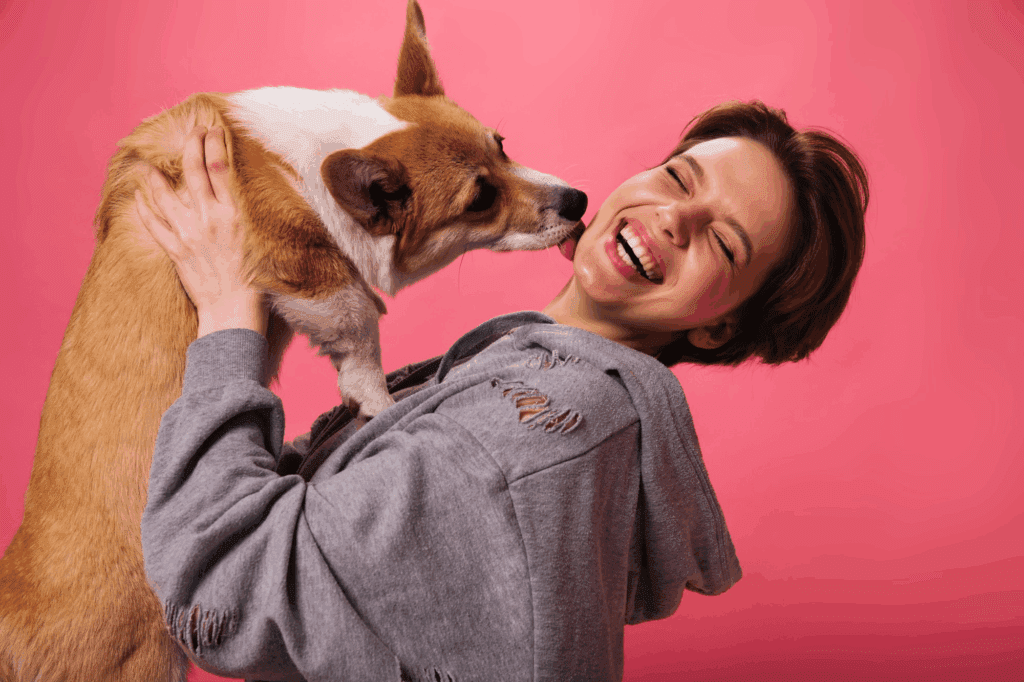
Psychology: People Who Talk To Their Pets Like They Are Humans Display Certain Emotional Traits
Talking to pets may seem like a quirky habit, but it reveals far more than a love for animals. The act of treating pets like people touches on deep emotional instincts, social behavior, and even cognitive development. While some may see it as silly, psychology offers a much more compelling explanation. Speaking to dogs, cats, birds, or even lizards as if they understand is not only normal but tied to specific emotional traits and mental well-being. Researchers have studied this behavior for years and found that it may indicate empathy, loneliness, or strong social cognition.
Anthropomorphism Is a Natural Part of the Human Mind
When a person gives human characteristics to animals, objects, or natural forces, it is known as anthropomorphism. This trait starts early in childhood. Kids talk to stuffed toys or believe their teddy bear feels sad when left alone. Psychologists note that this early behavior is developmentally healthy. It allows children to form social frameworks and explore emotions in safe ways. Adults who continue this behavior with pets are often showing remnants of that early developmental wiring. However, it also reflects more mature emotional expressions, such as nurturing tendencies and social bonding.
Talking to Pets Signals High Empathy and Emotional Intelligence
Several psychological studies show that people who talk to animals tend to score higher in empathy tests. Empathy is the ability to feel or understand what another person is experiencing. Even though animals do not communicate verbally, their body language and behavior allow humans to form emotional interpretations. Talking to them can reflect a deep sense of connection. According to a 2015 study published in the journal Anthrozoös, people who anthropomorphize pets often see their animals as full emotional partners. These individuals often describe their pets as “best friends” or “family members” rather than as property.
Loneliness Can Also Be a Driving Factor
For many, talking to pets fills a social gap. People who live alone, especially the elderly or socially isolated, tend to talk more frequently to their pets. This habit serves as a buffer against loneliness. It allows them to experience interaction and emotional response, even if the animal cannot speak. A report from the American Psychological Association in 2021 noted that older adults with pets showed lower rates of depression. They also felt more engaged with life, especially when they viewed their pets as active companions. Conversations with animals can create routines, which build structure into the day and reduce feelings of isolation.
Pet Conversations May Reduce Stress and Boost Mood
Engaging verbally with pets often involves a calming tone, affectionate nicknames, or playful exchanges. These small interactions can have measurable mental health effects. Studies from the Human-Animal Bond Research Institute show that talking to pets increases levels of oxytocin, a hormone linked to bonding and relaxation. The soothing rhythm of speaking to an animal can help regulate emotions, especially during stressful times. Just as people use meditation or breathing techniques, pet communication can be a form of emotional self-regulation. Pet owners who engage this way often report feeling calmer and more grounded.

People With High Social Cognition Tend to Talk to Pets More Often
Social cognition refers to how people process, store, and apply information about others in social contexts. Individuals with strong social cognition can better read emotional cues, understand intentions, and adapt their behavior in interactions. These same skills often translate into how people treat their pets. Talking to animals reflects a social brain that looks for cues, even in non-verbal forms. Pet owners often assign moods or reactions to their pets, such as saying a dog “looks guilty” or a cat “wants attention.” These interpretations require mental perspective-taking, a key part of social cognition. This explains why people in fields like teaching, therapy, or caregiving are often more likely to talk to their animals.
Read More: Which Dog Breeds Are the Smartest? These Clever Pups Made the Top of the List
It Reflects Strong Nurturing Instincts
People who talk to pets often display strong nurturing traits. This is especially true for individuals who care deeply for others and find satisfaction in taking care of living beings. The emotional reward of being needed, even by a non-verbal creature, reinforces these behaviors. Nurturing is not limited to parents or caregivers. It can be expressed through plant care, volunteering, or in this case, talking to pets. Research from the University of Chicago found that individuals who personify their pets tend to also express higher levels of care in other aspects of life, from supporting friends to helping strangers.
Neuroscience Explains the Brain’s Response to Animal Interaction
The brain’s reward system activates when humans interact with pets. MRI studies show that looking into a dog’s eyes activates the same part of the brain responsible for bonding between parents and children. This helps explain why many people feel compelled to speak to their pets as if they understand. The brain is literally forming a connection that mimics human bonding. Oxytocin levels rise in both the pet and the owner during these interactions, especially when combined with soft speech, touch, and eye contact. Neuroscience backs up what pet lovers already feel. The connection is real, even if it is not based on language.
Gender and Cultural Norms Influence Pet-Talking Behavior
While talking to pets is common across demographics, gender differences have been observed. Women are more likely than men to talk to animals using nurturing language. This does not mean men are less attached, but societal norms may shape how affection is expressed. In some cultures, speaking to pets is seen as childish or eccentric. In others, it is viewed as a sign of warmth and sensitivity. These cultural lenses affect how individuals perceive their own behavior. Regardless of culture or gender, the emotional traits behind the habit remain consistent. People who do this tend to be emotionally open, intuitive, and attuned to the feelings of others.
Not All Pet Talkers Are Lonely or Over-Attached
Some critics claim that talking to pets reflects emotional immaturity or social deficits. This assumption is not supported by most research. Many highly social, emotionally stable people talk to their pets simply because they feel joy doing it. It is a way to deepen the bond, express affection, or even practice emotional expression. Studies show that talking to pets is not linked to lower intelligence or poor social skills. On the contrary, it can be part of a rich emotional life and high cognitive flexibility. People who engage this way often also talk to babies, plants, or even cars. It reflects creativity and emotional engagement, not dysfunction.
Pet Names and Baby Talk Indicate Emotional Investment
The way people talk to their pets can reveal even more. Using baby talk or exaggerated expressions indicates a deeper emotional tie. Pet owners often use silly names, voices, or routines that resemble parenting. This kind of speech pattern is called “infant-directed speech” and is also used with human babies. It is high-pitched, repetitive, and emotionally expressive. Research shows that animals respond to these cues, especially dogs. They react more strongly to affectionate speech than to flat commands. This mutual response strengthens the bond and keeps the behavior going. It becomes a positive feedback loop of affection and attention.
Pets As Emotional Mirrors of Their Owners
Another emotional trait observed in pet talkers is projection. Projection occurs when a person assigns their own feelings to another being. People may say, “He’s mad I left him alone,” or “She knows I’m sad.” While pets do not understand complex language, they pick up on emotional tones. Owners who project their feelings often find comfort in the imagined empathy of their animals. This helps process emotions that may be hard to express with humans. Far from being unhealthy, this behavior can offer a safe outlet for emotional expression and reflection.
Children Who Grow Up Around Pets Often Imitate This Behavior
Kids who grow up in pet-owning homes often mirror their parents’ behavior. They may talk to pets during play, comfort them during storms, or include them in games. This social modeling reinforces empathy and teaches emotional awareness. Developmental psychologists see this as a healthy part of emotional growth. It strengthens early social skills and creates lasting emotional intelligence. Adults who grew up this way often carry these habits into their own lives. They are more likely to view animals as sentient beings and to talk to them as companions.
Pets Play an Active Role in the Emotional Lives of Their Owners
While animals do not talk back, they are active participants in this emotional exchange. Pets respond to tone, body language, and routine. Dogs wag their tails or tilt their heads when spoken to. Cats may purr, rub, or make eye contact. These responses reinforce the owner’s desire to talk. The interaction becomes a two-way bond, even without words. Owners feel seen, heard, and emotionally connected. This loop of interaction boosts confidence and builds a sense of safety and belonging.
Therapists Use Pet Interaction to Build Emotional Skills
In therapy, especially for children or trauma survivors, talking to pets can be a useful tool. Animal-assisted therapy uses dogs, horses, or even rabbits to help clients express emotions safely. Patients often find it easier to talk to animals first, before opening up to humans. This process helps rebuild trust and teaches emotional regulation. Therapists may encourage clients to describe what the animal might be feeling, which builds empathy and perspective-taking. These same traits are seen in people who talk to their pets in everyday life.
The Future of Pet Psychology May Shift How We Understand Relationships
As research continues to explore the human-animal bond, the psychological meaning behind pet-talking becomes clearer. It is not a strange habit or a harmless eccentricity. It is a window into the emotional traits that shape how humans connect, feel, and care. Whether it reflects empathy, loneliness, or simply joy, the habit of speaking to animals reflects a unique blend of emotional depth and social intelligence. Understanding these patterns can help improve not just pet care but also mental health and emotional well-being.
Read More: The Mental and Physical Health Benefits of Owning a Cat
Emotional Landscape of Pet-Talking
Talking to pets is far from meaningless. It reflects emotional richness, social cognition, and a strong bond with the natural world. Whether driven by empathy, habit, or the need for connection, this behavior is deeply human. As science continues to explore the emotional traits behind pet interaction, the simple act of chatting with a furry companion may reveal more about the heart than we ever imagined.
News in the same category


Disconnect WiFi at Night Sleep With the Phone on Airplane Mode in Another Room

The Hidden Dangers of Cooking with Aluminum Foil: Health Implications and Safer Alternatives

Japan Has Created a New Plastic That Dissolves in the Sea Within Hours and Enhances Soil Health

Scientists Reveal Simple Blood Test Can Detect Cancer Years Before Symptoms Appear

Bill Gates Says Only 3 Jobs Are Safe From AI — Are You In One Of Them?

People Unvaccinated Against COVID Are 48 Percent More Likely To Get Into Traffic Accidents

A ‘Zombie’ NASA Satellite Woke Up After 60 Years—And It Sent Out A Powerful Radio Pulse

Scientists Claim That If Humans Go Extinct, Octopuses Have The Best Chance Of Building The Next Civilization

23-Year-Old Ukranian Discovers Way To Make Paper From Fallen Leaves Without Cutting Down Trees

Rare ‘Doomsday’ Oarfish Washes Ashore In Tasmania, Igniting Superstitions Of Impending Disaster

No one knows why 13 trucks are blocking the highway, when the truth is revealed, tears flow

Controversial Inventor’s Mysterious Death Sparks Debate Over Alternative Energy Suppression

Only two places are safe in a nuclear war, expert says

Woman Claims to Be Part of the 0.00001% Who Remembers Every Moment of Her Life—Including Before Birth

5 Countries Tighten Immigration Rules, Making It Tougher For Americans To Move Abroad

Gulf Stream On The Brink Of Collapse — Scientists Warn Of Global Catastrophe

French Farmer Discovers $4 Billion Gold Deposit, But Legal Hurdles Prevent Him From Profiting

Inside The Global Seed Vault: Earth’s ‘Safest Place’ Only Opens Six Times A Year
News Post

Surprising Triggers: What May Be Causing Your Hives (Urticaria)

The Truth Behind ‘Durex’: What Its Name Actually Stands For Has Stunned Many

Your Eyes: Windows to Your Health – Uncovering Diabetes and Cancer Through Vision

It’s Official! Mexico City Has Banned Bullfighting, Ending A 500-Year-Old Tradition

Disconnect WiFi at Night Sleep With the Phone on Airplane Mode in Another Room

The Hidden Dangers of Cooking with Aluminum Foil: Health Implications and Safer Alternatives

Japan Has Created a New Plastic That Dissolves in the Sea Within Hours and Enhances Soil Health

Scientists Reveal Simple Blood Test Can Detect Cancer Years Before Symptoms Appear

Bill Gates Says Only 3 Jobs Are Safe From AI — Are You In One Of Them?

5 Early Warning Signs of Cancer in Children: Parents Must Know to Save Their Child

People Unvaccinated Against COVID Are 48 Percent More Likely To Get Into Traffic Accidents

If Your Body Has a Bad Odor in These 3 Areas, It Could Mean Poor Liver Detox and Declining Function – Get Checked Before It’s Too Late!

Warning: If You Notice This Symptom in Your Body, Go to the Hospital Immediately – It Could Be Late-Stage Nasopharyngeal Cancer

A ‘Zombie’ NASA Satellite Woke Up After 60 Years—And It Sent Out A Powerful Radio Pulse

Scientists Claim That If Humans Go Extinct, Octopuses Have The Best Chance Of Building The Next Civilization

23-Year-Old Ukranian Discovers Way To Make Paper From Fallen Leaves Without Cutting Down Trees

Rare ‘Doomsday’ Oarfish Washes Ashore In Tasmania, Igniting Superstitions Of Impending Disaster

Sore Throat Relief: How Ginger Can Soothe Your Throat Naturally
